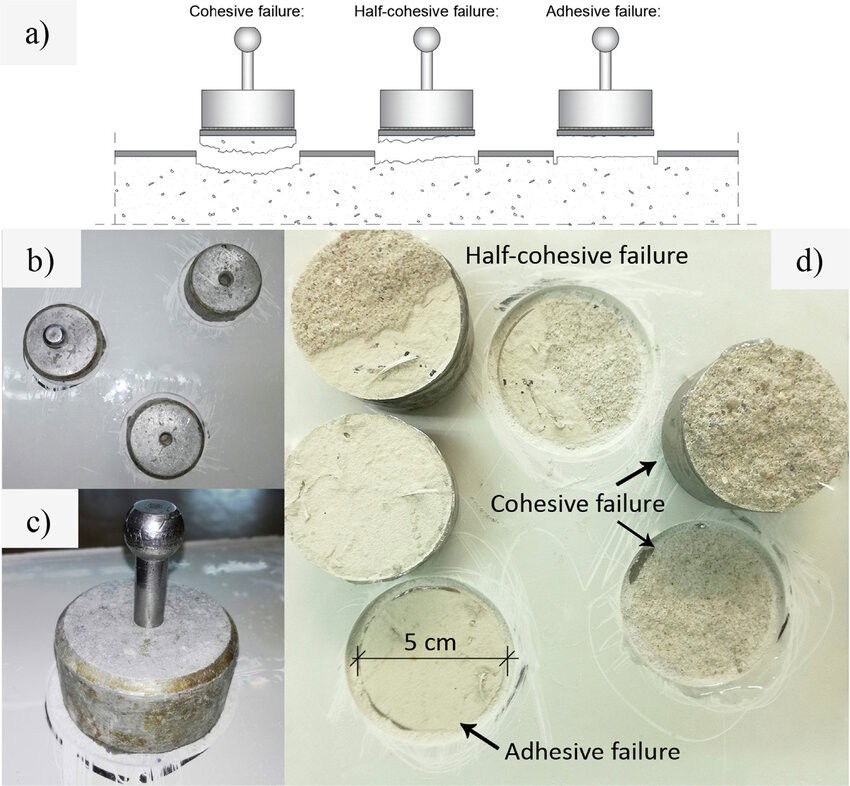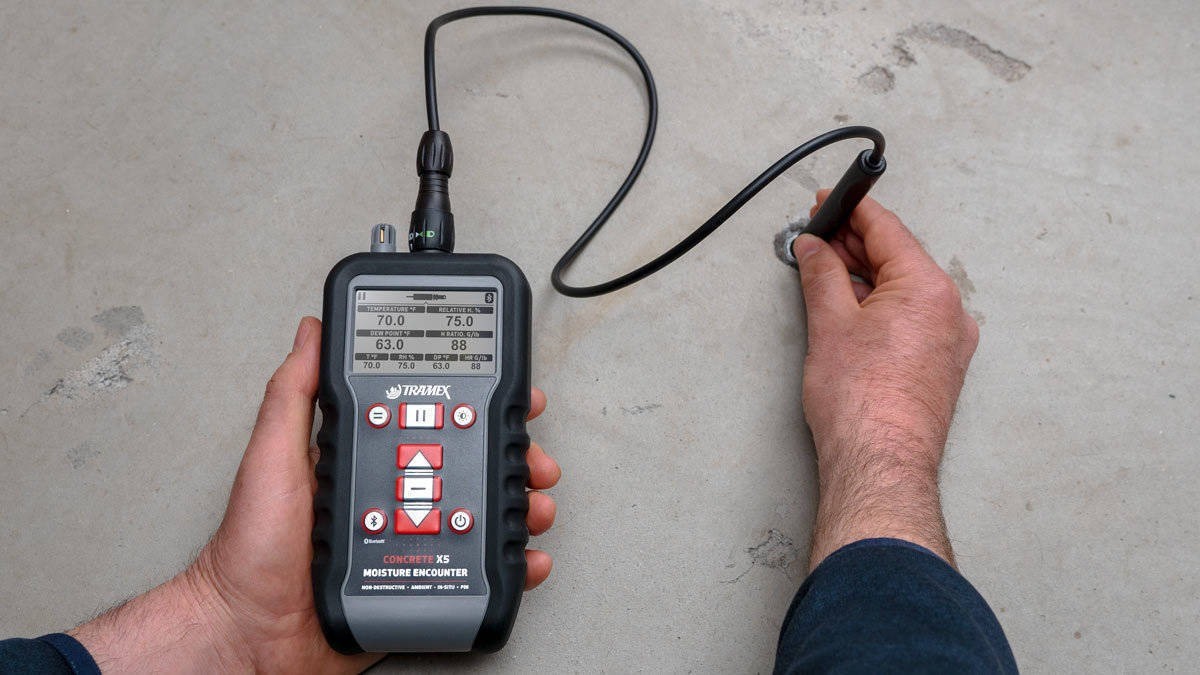Regarding safeguarding the integrity of concrete structures, the bond between the substrate and the applied coating plays a pivotal role. Ensuring this bond remains robust for industrial floors is essential for long-term durability. This is where adhesion testing steps in as a critical quality control measure.
Adhesion testing is a reliable method to quantify the strength of the bond between the concrete substrate and the applied coating. By subjecting the interface between these layers to rigorous evaluation, inspectors and maintenance professionals gain valuable insights into the structural integrity and performance of the coating system.
Routine adhesion tests are integral to inspection and maintenance procedures for concrete surfaces coated with protective or decorative finishes. These tests serve several key purposes:
1. Detecting Potential Coating Failures: Adhesion tests help identify any weaknesses or deficiencies in the bond between the coating and the substrate. Early detection of such issues allows timely remediation, preventing more extensive damage or failures.
2. Ensuring Compliance with Standards: Adhesion testing is often mandated by industry standards and specifications to ensure that coating applications meet the required performance criteria. By conducting these tests, stakeholders can verify compliance with relevant regulations and guidelines.
3. Guiding Maintenance Strategies: The results of adhesion tests provide valuable data for developing targeted maintenance strategies. Understanding the condition of the coating-substrate bond enables informed decisions regarding maintenance schedules, repair priorities, and coating recoating intervals.
Several methods are available for conducting adhesion tests, including pull-off tests, tape tests, and scratch tests. Each method offers unique advantages and is selected based on coating type, substrate condition, and project requirements.
Pull-off tests, for instance, involve applying a controlled tensile force to a specialized test apparatus attached to the coating surface. The force required to detach the coating from the substrate is measured, providing a quantitative assessment of adhesion strength.
Similarly, tape tests involve applying adhesive tape to the coated surface and removing it rapidly. The extent of coating removal from the substrate indicates adhesion quality, with minimal or no coating transfer indicative of strong adhesion.
Incorporating adhesion testing into inspection and maintenance protocols empowers stakeholders to proactively manage the integrity of coated concrete structures. By identifying potential coating failures early on and implementing appropriate remedial measures, the longevity and performance of these structures can be effectively safeguarded.
In conclusion, adhesion testing is a cornerstone of concrete coatings’ quality assurance and maintenance practices. By evaluating the bond strength between the coating and substrate, these tests enable stakeholders to mitigate risks, ensure compliance, and uphold the longevity of coated concrete assets.
Interpreting the results of measurements
Interpreting the results of measurements for self-levelers and epoxy coatings on concrete involves understanding specific requirements and standards set for these materials.
1. ASTM Standards: ASTM International provides standards for testing and interpreting the performance of self-leveling compounds and epoxy coatings on concrete. For self-levelers, ASTM F710 outlines requirements for evaluating the bond strength of these compounds to concrete substrates. For epoxy coatings, standards such as ASTM D7234 guide the evaluation of the adhesion strength of coatings applied to concrete surfaces.
2. Adhesion Strength: One crucial aspect of interpreting results is assessing the adhesion strength between the self-leveler or epoxy coating and the concrete substrate. This strength indicates how well the material bonds to the concrete surface. Adhesion strength is typically measured in pounds per square inch (psi) or megapascals (MPa).
3. Pull-Off Tests: Pull-off tests are commonly used to evaluate adhesion strength. In these tests, a specialized instrument applies a perpendicular force to the coating surface, gradually pulling it away from the substrate until failure occurs. The force required to detach the coating provides a quantitative measure of adhesion strength.

4. Acceptance Criteria: Adherence to specific acceptance criteria is essential for determining the suitability of self-levelers and epoxy coatings. These criteria often vary depending on the intended application, environmental conditions, and project specifications. For example, ASTM F710 specifies minimum bond strength requirements for self-leveling compounds applied to concrete substrates.
5. Surface Preparation: Proper surface preparation is critical for achieving optimal adhesion between the coating and concrete substrate. Surface contaminants, moisture, and roughness can adversely affect adhesion strength. Therefore, when interpreting measurement results, one should consider whether appropriate surface preparation procedures were followed according to industry standards.
6. Visual Inspection: Besides quantitative measurements, visual inspection plays a vital role in interpreting results. Examine the coating-substrate interface for signs of adhesion failure, such as delamination, blistering, or cracking. Visual cues provide qualitative insights into the overall performance and durability of the coating system.
7. Documentation and Reporting: Documenting measurement results, testing procedures, and any deviations from standard protocols is crucial for accurate interpretation and traceability. Prepare comprehensive reports that include numerical data, photographs, and observations to facilitate effective decision-making and communication among project stakeholders.

Selecting the right floor coating system is important for proper adhesion to concrete. However, the key to achieving good adhesion is selecting an appropriate primer. The first layer of a coating system is crucial as it bonds directly to the substrate. While adhesion testing does not indicate how long a coating will last, it is a good indicator of the overall quality of a flooring system. Flooring failures are rare, but when they occur, they are usually due to applicator or mixing errors, improper substrate preparation, or water mitigation issues. Choosing a coating system with a primer with an adhesion pull-off strength 64.3% lower than that of other readily available coatings is unwise.
In conclusion, adhesion testing is an indispensable aspect of coating processes, offering invaluable insights into the strength and durability of coating-substrate bonds. By facilitating early detection of potential failures and ensuring adherence to quality standards, adhesion testing is pivotal in enhancing coated surfaces’ performance, reliability, and longevity across diverse industries. Embracing robust adhesion testing methodologies safeguards investments in coating applications and fosters a culture of excellence and reliability in materials engineering and maintenance practices.






